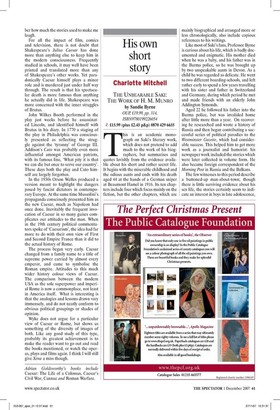His own short story
Charlotte Mitchell THE UNBEARABLE SAM: THE WORK OF H. M. MUNRO by Sandie Byrne OUP £19.99, pp. 314, ISBN9780199226054 £15.99 (plus £2.45 p&p) 0870 429 6655 This is an academic monograph on Saki's literary work, which does not pretend to add much to the work of his biographers, but summarises and quotes lavishly from the evidence available about his short and rather secret life. It begins with the miserable childhood and the odious aunts and ends with his death aged 44 at the hands of a German sniper at Beaumont Hamel in 1916. Its ten chapters include four which focus mainly on the fiction, but the other chapters, which are mainly biographical and arranged more or less chronologically, also include copious references to his writings.
Like most of Saki's fans, Professor Byrne is curious about his life, which is badly documented and enigmatic. His mother died when he was a baby, and his father was in the Burma police, so he was brought up by two unspeakable aunts in Devon. As a child he was regarded as delicate. He went to two different boarding-schools, and left rather early to spend a few years travelling with his sister and father in Switzerland and Germany, during which period he met and made friends with an elderly John Addington Symonds.
Aged 22 he followed his father into the Burma police, but was invalided home after little more than a year. On recovering he researched and wrote a history of Russia and then began contributing a successful series of political parodies to the Westminster Gazette, which had considerable success. This helped him to get more work as a journalist and humorist: his newspaper work included the stories which were later collected in volume form. He also became foreign correspondent of the Morning Post in Russia and the Balkans.
The few witnesses to this period describe a buttoned-up man-about-town; though there is little surviving evidence about his sex life, the stories certainly seem to indicate an interest in boys in late adolescence, and his most assiduous biographer, A. J. Langguth, thought this was not repressed. By 1914 Saki had published four volumes of stories and two novels. Two more volumes of stories were collected from periodicals and published soon after his death, and literary historians have subsequently disinterred a few more.
On the outbreak of war he lied about his age and enlisted in the ranks. Surviving letters from this period show an enthusiasm for the war which is the kind of thing modern academics can't stand, and which is also hard to reconcile with the gay, callous brutality of the short stories: 'It seems almost too good to be true that I am going to take an active part in a big European war.'
The Wildean affectation of Clovis and Reginald is a long way off, but this position, which does not seem to have been revised on contact with war in reality, is much closer to the mood of his second novel, the invasion scare story, When William Came: A Story of London under the Hohenzollems (1913). Here Saki gives vent to a fear of the emasculation and suburbanisation of the male which turns up elsewhere in late Victorian and Edwardian fiction. The novel is a fantasy in which England has been subjugated by Germany because its men have become clerks instead of warriors and because modernity has cut off contact with the primeval forces of nature. Byrne is at her most interesting when she discusses Saki's interest in the savage, and the way in which untamed boys, like Gabriel-Ernest, and wild animals, like Sredni Vashtar, symbolise the forces which oppose conformist bourgeois urban society, which frequently figures in his work as an ugly, dominating, life-denying middleaged woman. Her best chapter is entitled 'The Men that Wolves have Sniffed at, the Wild, and the Boys'.
It can't be denied that the task of using the stories to flesh out the limited evidence for the life, while simultaneously ransacking the life to help with the interpretation of the work, is a difficult one to pull off. The structure of the book is a little confusing as a result. The stories, moreover, have a polish which threatens to make any kind of commentary sound rather plonking. Byrne herself says of her subject that there are `few writers less profitable to write about'. This observation occurs on page 15, and is not really calculated to encourage the reader. The book has curious features. As well as errors in proper names which suggest an overdependence on spellcheck, there are odd transitions which make it read like an early draft. A discussion of the implications of the pseudonym Saki on pages 102-3 breaks off abruptly and is resumed without explanation on page 172. Some cynical academic readers may wonder whether the book was hurried into print to beat the deadline for the Research Assessment Exercise.






































































 Previous page
Previous page